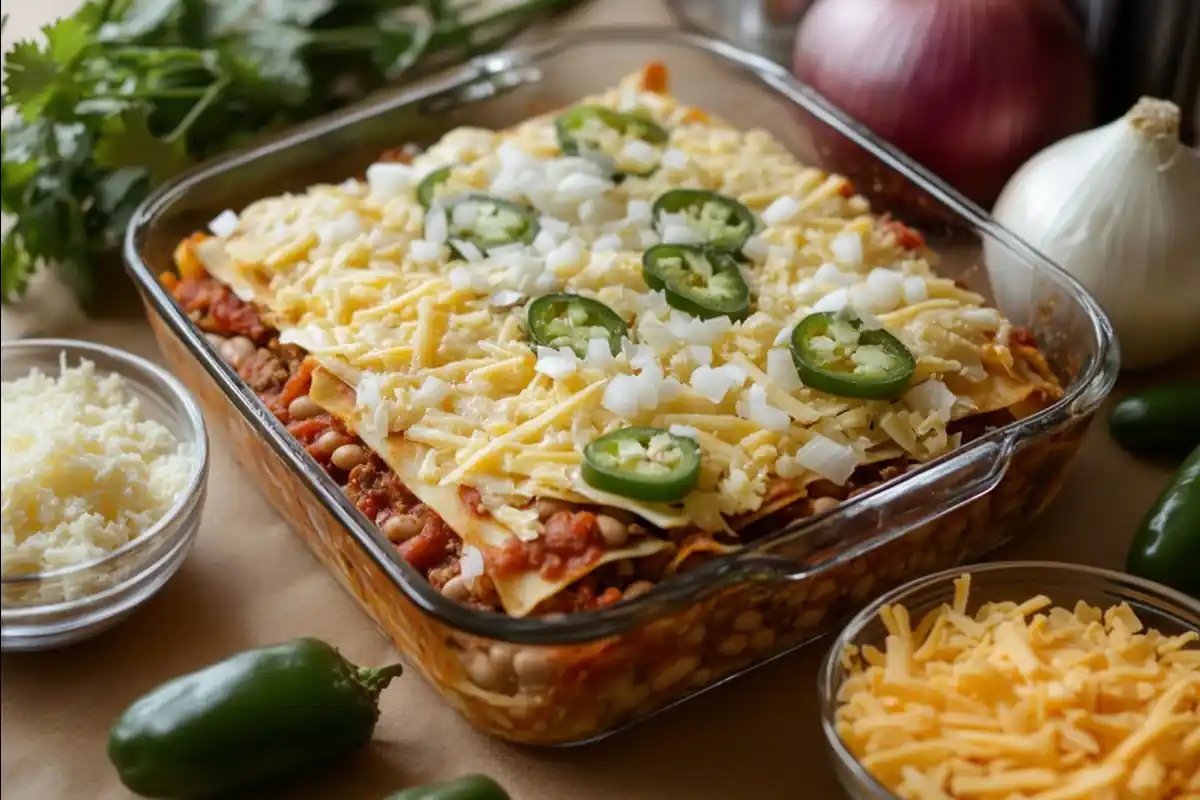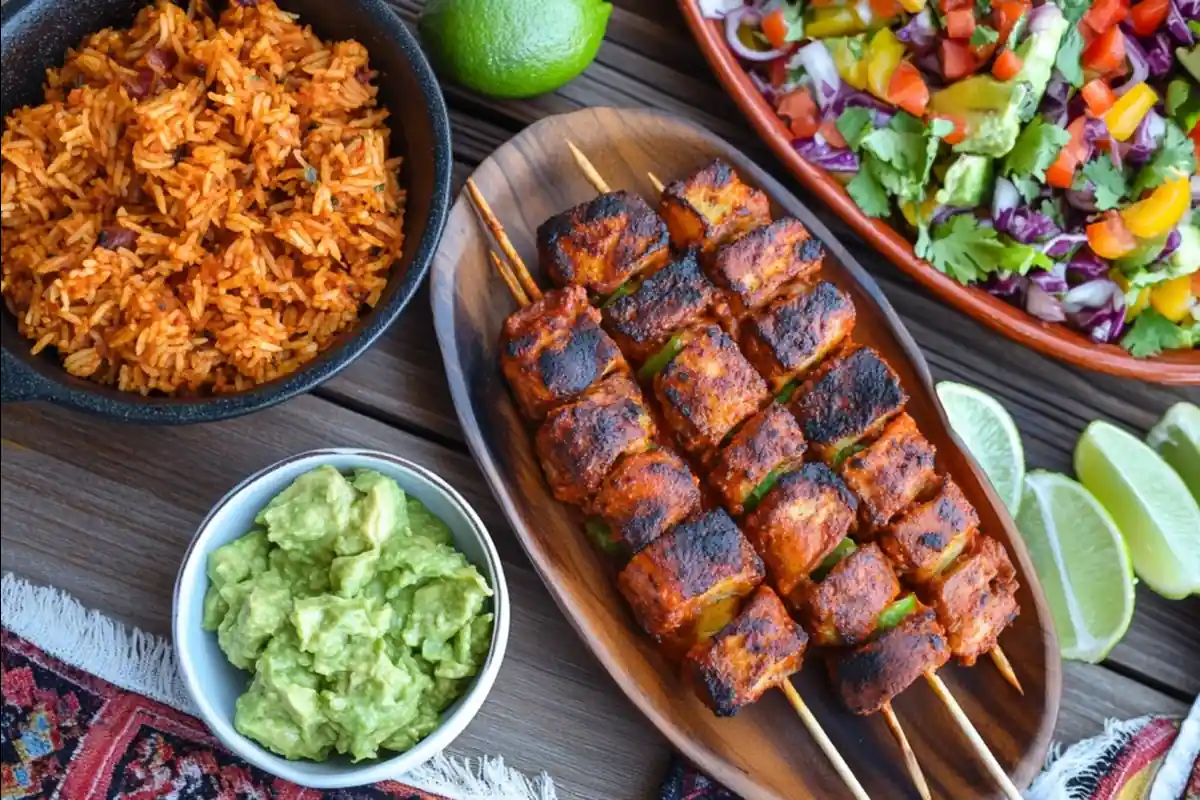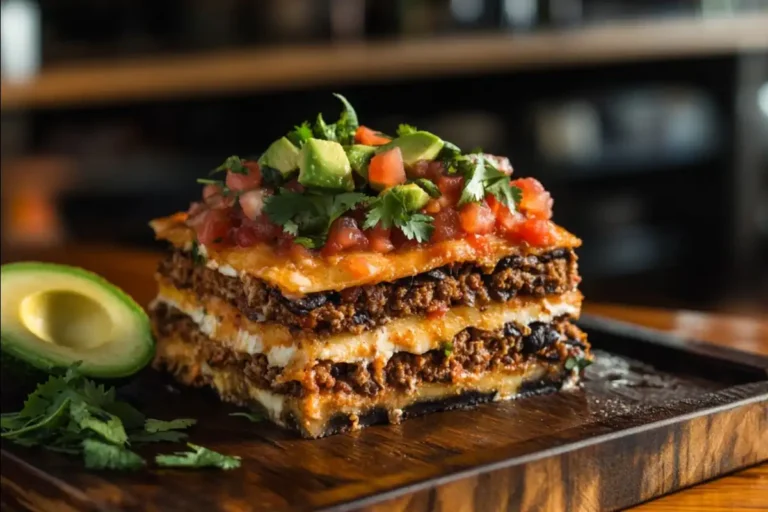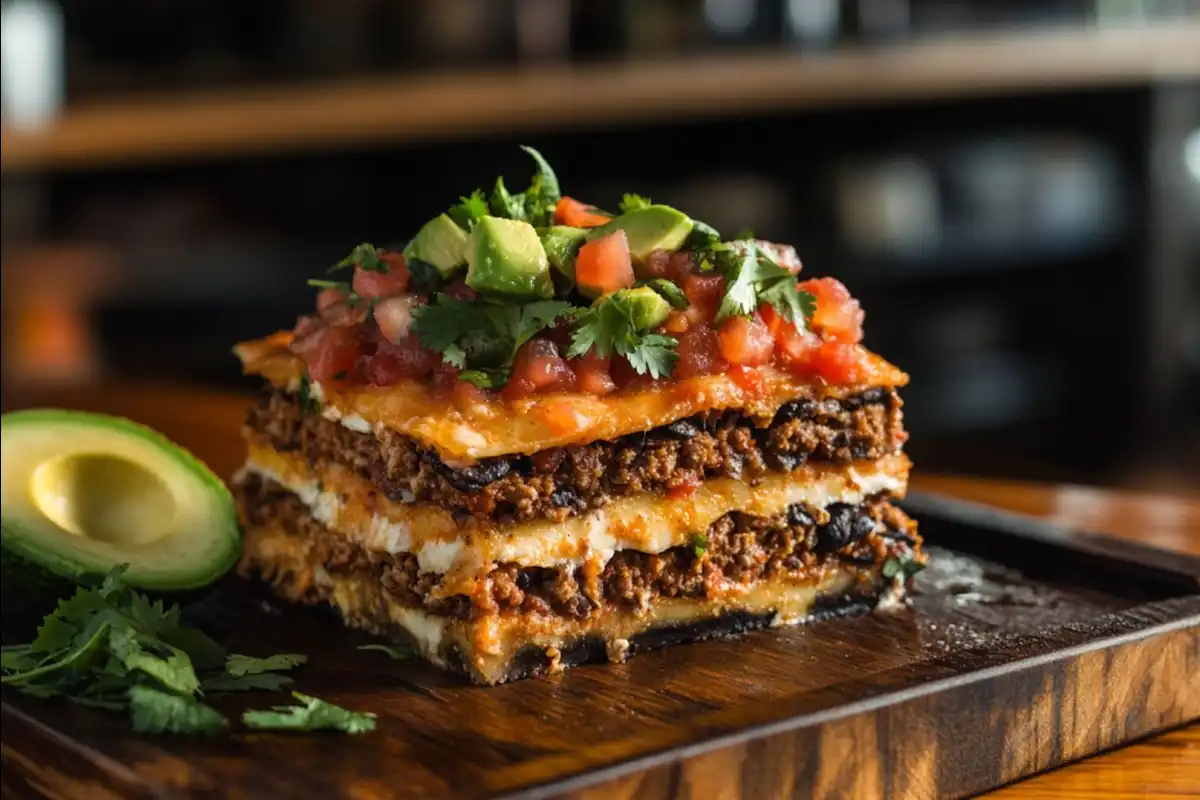Mexican lasagna is the ultimate fusion dish, blending the comforting structure of traditional Italian lasagna with the bold and vibrant flavors of Mexican cuisine. This layered masterpiece is a crowd-pleaser, perfect for family dinners or gatherings, and offers endless opportunities for customization. In this article, we’ll dive deep into what makes Mexican lasagna so special, exploring its key ingredients, history, variations, and more. If you’ve ever wondered “What Is Mexican Lasagna Made Of?”, you’re about to get all the answers—and then some.
1: Introduction to Mexican Lasagna
What is Mexican Lasagna?
At its core, Mexican lasagna is a layered casserole that borrows its concept from Italian lasagna but substitutes many traditional ingredients with Mexican staples. Instead of pasta sheets, this dish often uses tortillas as the base, creating a unique texture that complements the rich layers of meat, beans, cheese, and spices. It’s a celebration of culinary creativity, combining the best of two beloved cuisines.
Fusion of Cultures: Italian Meets Mexican Cuisine
The magic of Mexican lasagna lies in its ability to bring together two distinct culinary traditions. Italian lasagna is known for its hearty, cheesy, and tomato-based flavors, while Mexican cuisine emphasizes bold, zesty, and spicy elements. By layering tortillas with seasoned meats, beans, salsa, and gooey cheese, Mexican lasagna captures the essence of both worlds in a way that feels familiar yet entirely new.
Whether you’re a fan of traditional Mexican food or someone who loves experimenting in the kitchen, Mexican lasagna offers something for everyone. It’s versatile, customizable, and downright delicious. From weeknight dinners to potluck favorites, this dish has found its way into the hearts (and stomachs) of people across the globe.
2: Key Ingredients in Mexican Lasagna
Essential Base: Tortillas vs. Lasagna Noodles
The backbone of any Mexican lasagna is its layers, and here’s where it diverges from the Italian classic. Instead of traditional lasagna noodles, most recipes opt for corn or flour tortillas. These bring an authentic Mexican touch to the dish, complementing the bold spices and creating a uniquely satisfying texture. The tortillas soak up the rich flavors while holding the layers together beautifully. For those who crave a creative twist, using flatbread or even tostadas can be an option.
Meat Options: Ground Beef, Chicken, or Turkey
The protein layer in Mexican lasagna is incredibly versatile. Ground beef seasoned with chili powder, cumin, and paprika is a popular choice, but alternatives like shredded chicken or ground turkey can provide a lighter yet equally flavorful base. For a spicier kick, chorizo or spicy sausage can replace the traditional meats. Vegetarians can substitute beans or plant-based crumbles for a meatless version.
Cheese Choices: Cheddar, Monterey Jack, or Pepper Jack
Cheese is the glue that ties everything together in Mexican lasagna. A mix of sharp cheddar and gooey Monterey Jack works wonders, while the addition of pepper jack can bring a subtle heat. The key is to use cheese that melts well, creating that irresistible, bubbly top layer that’s hard to resist.
Additional Components: Beans, Salsa, and Vegetables
Layers of refried beans or black beans add a hearty texture, while salsa infuses the dish with a tangy, spicy kick. Veggies like diced tomatoes, corn, bell peppers, and jalapeños can be added to boost the nutritional value and elevate the flavor profile. Some recipes even sprinkle in fresh cilantro for a burst of freshness.
What Is Mexican Lasagna Made Of? The answer lies in its harmonious combination of these ingredients, tailored to personal tastes. This flexibility is what makes the dish a favorite for weeknight dinners and potlucks alike.
3: History and Cultural Significance of Mexican Lasagna
Origins and Evolution
While its exact origins are debated, Mexican lasagna is believed to have emerged in the United States during the 1980s. Mexican-American communities likely created this dish as a way to blend the comforting structure of lasagna with the bold flavors of their cultural cuisine. This fusion was a culinary answer to combining the familiar with the innovative, resulting in a dish that resonated with diverse tastes.
Adoption in Southwestern United States
The Southwestern U.S., with its deep-rooted Mexican influence, quickly embraced Mexican lasagna. It became a staple at family gatherings and community events, cherished for its hearty appeal and adaptability. The dish perfectly encapsulated the region’s love for zesty, spice-forward flavors, layered in a way that felt traditional yet adventurous.
Why It’s a Modern Comfort Food
Today, Mexican lasagna enjoys widespread popularity across the globe. It’s the ultimate comfort food—simple to make, easy to customize, and packed with bold flavors that leave a lasting impression. Whether made for a casual dinner or a festive occasion, this dish symbolizes the power of culinary fusion, showcasing how diverse cultures can create something extraordinary together.
4: Variations on the Classic Recipe
Experimenting with Proteins
One of the best things about Mexican lasagna is its adaptability. If ground beef isn’t your favorite, there are plenty of other options. Shredded chicken seasoned with taco spices creates a lighter yet still flavorful alternative. Ground turkey offers a leaner option for those watching their calorie intake. For seafood lovers, shrimp sautéed with garlic and lime makes an unexpected yet delightful twist. Each variation opens up new ways to enjoy this versatile dish.
Vegetarian and Vegan Options
Vegetarians can create a robust Mexican lasagna by skipping the meat and relying on hearty ingredients like black beans, refried beans, and roasted vegetables. Sweet corn, zucchini, and bell peppers can add texture and sweetness, making the dish even more satisfying. For vegans, dairy-free cheese and plant-based meat crumbles allow them to indulge in this layered delight without compromise. With so many plant-based products available today, making a vegan Mexican lasagna is easier than ever.
Adding Spices and Peppers for Heat
For those who crave a fiery kick, experimenting with spices and peppers is a must. Jalapeños, habaneros, or even chipotle peppers can turn up the heat. Spice blends like chili powder, cumin, and smoked paprika further elevate the flavor. Want to try something different? Adding fresh cilantro or squeezing lime juice over the finished dish can brighten the flavors while balancing the heat.
For more creative recipe ideas, check out our recipe guide.
5: Step-by-Step Guide to Making Mexican Lasagna

Gathering Ingredients and Tools
Before diving into the process, gather everything you need. Ingredients include tortillas, seasoned meat or a vegetarian substitute, refried beans, salsa, shredded cheese, and spices like chili powder and cumin. Tools such as a large skillet, a baking dish, and a mixing bowl will streamline the process.
Preparing the Layers: Meat, Beans, and Tortillas
Start by cooking the meat (or plant-based substitute) with onions, garlic, and spices until fully cooked. Set it aside. Heat the refried beans in a separate pan to make them easier to spread. Lay out your tortillas, ensuring they are soft enough to layer easily.
Assembling and Baking the Dish
In a greased baking dish, start with a layer of tortillas as the base. Spread a thin layer of refried beans, followed by the meat mixture, salsa, and a generous sprinkle of shredded cheese. Repeat this process until the dish is filled, finishing with a top layer of cheese. Bake at 375°F (190°C) for 25-30 minutes, or until the cheese is melted and bubbly.
Pro Tips for Flavor Enhancement
For an extra-crispy top layer, broil the lasagna for the last 2-3 minutes of baking. To add freshness, garnish with chopped cilantro, diced avocado, or a dollop of sour cream. Want more zest? Serve with a side of lime wedges or homemade guacamole.
What Is Mexican Lasagna Made Of? It’s a creative combination of layers and bold flavors, and this step-by-step guide ensures you’ll nail it every time. For another easy, flavorful dinner idea, explore chicken pita recipes.
6: Quick and Easy Shortcuts for Busy Weeknights
Using Pre-Made Ingredients
For those hectic nights when time is short, pre-made ingredients are a lifesaver. Pre-cooked tortillas, canned refried beans, jarred salsa, and shredded cheese can drastically cut down on prep time. Using a store-bought taco seasoning mix instead of blending your spices can also simplify the process. While these shortcuts don’t sacrifice flavor, they make creating Mexican lasagna faster and more accessible for busy households.
Time-Saving Techniques: Slow Cookers and Freezing
A slow cooker is another excellent way to streamline the preparation of This dish. Simply layer the ingredients in the cooker, set it on low for 4-6 hours, and let it cook while you go about your day. Alternatively, you can assemble the lasagna ahead of time, freeze it, and bake it straight from the freezer when needed. These methods are perfect for meal prepping or serving a hungry crowd with minimal effort.
With these shortcuts, What Is Mexican Lasagna Made Of? becomes less about time-consuming prep and more about enjoying its rich, flavorful layers. Whether it’s a slow-cooker version or a make-ahead freezer meal, this dish adapts to your schedule.
7: Best Side Dishes to Pair with Mexican Lasagna

Refreshing Salads
A crisp, refreshing salad is a perfect partner to the rich layers of Mexican lasagna. Try a simple salad with lettuce, tomatoes, cucumbers, and avocado, dressed in lime juice and olive oil. Adding a sprinkle of Cotija cheese or crushed tortilla chips can tie the flavors together beautifully. A tangy slaw with red cabbage and cilantro also provides a zesty contrast to the warm, cheesy dish.
Mexican Rice and Bean Combos
Mexican rice, with its vibrant color and seasoning, is a classic side that complements Mexican lasagna perfectly. Cooked with tomatoes, onions, and spices, it adds a flavorful base to the meal. Black beans or refried beans served on the side provide extra protein and texture, ensuring a hearty and satisfying dinner.
Spicy Add-Ons: Guacamole and Jalapeño Poppers
For those who love a bit of heat, spicy sides are a must. Fresh guacamole with a dash of lime and jalapeño pairs well with the bold flavors of Mexican lasagna. Jalapeño poppers stuffed with cream cheese or queso fresco can serve as a spicy appetizer or an exciting side dish.
Whatever your choice, pairing these sides with Mexican lasagna creates a well-rounded meal that highlights the vibrant flavors of Mexican cuisine. Curious about more recipes? Check out our Easy Baked Taco Lasagne Without Browning Ground Beef Recipe for another delicious twist on a layered favorite!
8: Tips for Serving and Storing Mexican Lasagna
Proper Storage Techniques
After enjoying your delicious Mexican lasagna, storing leftovers properly is key to preserving its flavor and texture. Allow the dish to cool completely before transferring it to an airtight container. This prevents condensation, which can make the lasagna soggy. Refrigerate it for up to three days, or freeze it for longer storage. To freeze, wrap the dish tightly in plastic wrap and aluminum foil to avoid freezer burn.
Reheating Tips to Retain Flavor
When reheating refrigerated lasagna, the oven is your best bet to bring back its original taste and texture. Cover the dish with foil and bake at 350°F (175°C) until it’s heated through, typically 20-30 minutes. Adding a splash of water or broth can keep the layers moist. For frozen lasagna, allow it to thaw overnight in the refrigerator before reheating.
With these storage and reheating tips, you’ll be ready to enjoy What Is Mexican Lasagna Made Of? even on the busiest days. Leftovers can be just as delightful as the first serving when handled with care.
9: Frequently Asked Questions (FAQs)
What is the difference between lasagna and lasagna al forno?
The terms may sound interchangeable, but there’s a subtle distinction. While both refer to layered pasta dishes, “lasagna al forno” specifically means “baked lasagna” in Italian. It’s a traditional term highlighting the oven-baked method of preparation. Similarly, Mexican lasagna adopts this style, swapping noodles for tortillas but keeping the baked layers intact.
How many calories are in Mexican lasagna?
The calorie count in Mexican lasagna depends on the ingredients used. A typical serving with ground beef, cheese, and refried beans ranges from 300 to 400 calories. For lighter options, substitute lean meats, low-fat cheese, or plant-based ingredients.
What was the original lasagna made of?
The earliest versions of lasagna date back to ancient Greece and Rome, where they used flat sheets of pasta layered with sauces and cheese. Over time, the dish evolved into the rich, tomato-based lasagna we know today. Mexican lasagna pays homage to this layered tradition, infusing Mexican flavors for a fresh twist.
What is the difference between lasagne and lasagna?
“Lasagne” is the plural Italian term for the pasta sheets, while “lasagna” refers to the whole dish. Outside of Italy, “lasagna” is commonly used to describe the dish itself. Regardless of spelling, What Is Mexican Lasagna Made Of? remains the same: layers of tortillas, cheese, and bold Mexican flavors.
Conclusion: Why Mexican Lasagna is a Must-Try Dish
Fusion at Its Best: A Dish for Every Occasion
Mexican lasagna isn’t just a recipe; it’s a testament to culinary creativity. This dish combines the layered comfort of Italian lasagna with the zesty, bold flavors of Mexican cuisine, creating a meal that’s as delicious as it is versatile. Whether it’s for a family dinner, a potluck, or even meal prep, Mexican lasagna offers something for everyone. Its adaptability allows you to tailor it to your preferences, from protein choices to spice levels.
Endless Customization Possibilities
The beauty of Mexican lasagna lies in its endless customization. Whether you’re a fan of traditional flavors or love experimenting with new ingredients, this dish can evolve with your tastes. It’s perfect for accommodating dietary needs, offering options for vegetarians, vegans, and those following gluten-free diets. No matter how you prepare it, the layers of tortillas, cheese, and flavorful fillings guarantee a satisfying and memorable meal.
So, What Is Mexican Lasagna Made Of? It’s made of more than just ingredients—it’s a blend of culture, comfort, and creativity that you’ll want to make again and again. Gather your ingredients, layer your dish, and experience this vibrant fusion of flavors in your own kitchen. It’s time to give Mexican lasagna a try!
Print
What Is Mexican Lasagna Made Of?
This Mexican Lasagna is a delicious fusion of Italian and Mexican flavors, featuring layers of seasoned ground beef, creamy refried beans, gooey cheese, and soft tortillas instead of traditional pasta. Topped with zesty salsa and fresh toppings, this easy-to-make dish is perfect for family dinners or gatherings.
- Total Time: 45 minutes
- Yield: 6 servings 1x
Ingredients
- 1 lb ground beef (or ground turkey)
- 1 small onion, chopped
- 2 cloves garlic, minced
- 1 packet taco seasoning
- 1 can (15 oz) black beans, drained and rinsed
- 1 can (16 oz) refried beans
- 1 can (10 oz) diced tomatoes with green chilies
- 1 cup corn kernels (fresh, canned, or frozen)
- 1 can (8 oz) tomato sauce
- 1 cup salsa
- 8 small flour or corn tortillas
- 2 cups shredded Mexican cheese blend
- ½ cup sour cream (for topping, optional)
- ¼ cup chopped fresh cilantro (for garnish)
- 1 jalapeño, sliced (optional)
Instructions
- Preheat Oven – Set your oven to 375°F (190°C). Grease a 9×13-inch baking dish.
- Cook Meat – In a large skillet over medium heat, cook ground beef with onions and garlic until browned. Drain excess fat.
- Season & Mix – Stir in taco seasoning, diced tomatoes with green chilies, tomato sauce, and corn. Simmer for 5 minutes.
- Layer Ingredients – Spread a thin layer of salsa at the bottom of the baking dish. Place two tortillas on top. Spread refried beans, then add a portion of the meat mixture, followed by shredded cheese. Repeat layers until all ingredients are used, finishing with cheese on top.
- Bake – Cover with foil and bake for 20 minutes. Remove foil and bake for another 10 minutes until the cheese is melted and bubbly.
- Garnish & Serve – Let the lasagna cool for 5 minutes. Top with sour cream, fresh cilantro, and sliced jalapeños. Serve warm and enjoy!
Notes
- Substitute ground beef with ground turkey or a meatless alternative for a lighter option.
- Use whole wheat tortillas for added fiber.
- For a spicier kick, mix in extra chili powder or cayenne pepper.
- Prep Time: 15 minutes
- Cook Time: 30 minutes
- Category: Main Course, Casserole
- Method: Baking
- Cuisine: Mexican, Tex-Mex
Nutrition
- Serving Size: Per Serving
- Calories: ~450
- Sodium: 900mg
- Fat: 20g
- Carbohydrates: 40g
- Fiber: 6g
- Protein: 25g
Keywords: Mexican lasagna, taco lasagna, layered Mexican casserole, easy Mexican dinner, Tex-Mex lasagna, cheesy Mexican dish, ground beef casserole, tortilla lasagna, spicy lasagna, family-friendly recipe.


3 thoughts on “What Is Mexican Lasagna Made Of?”